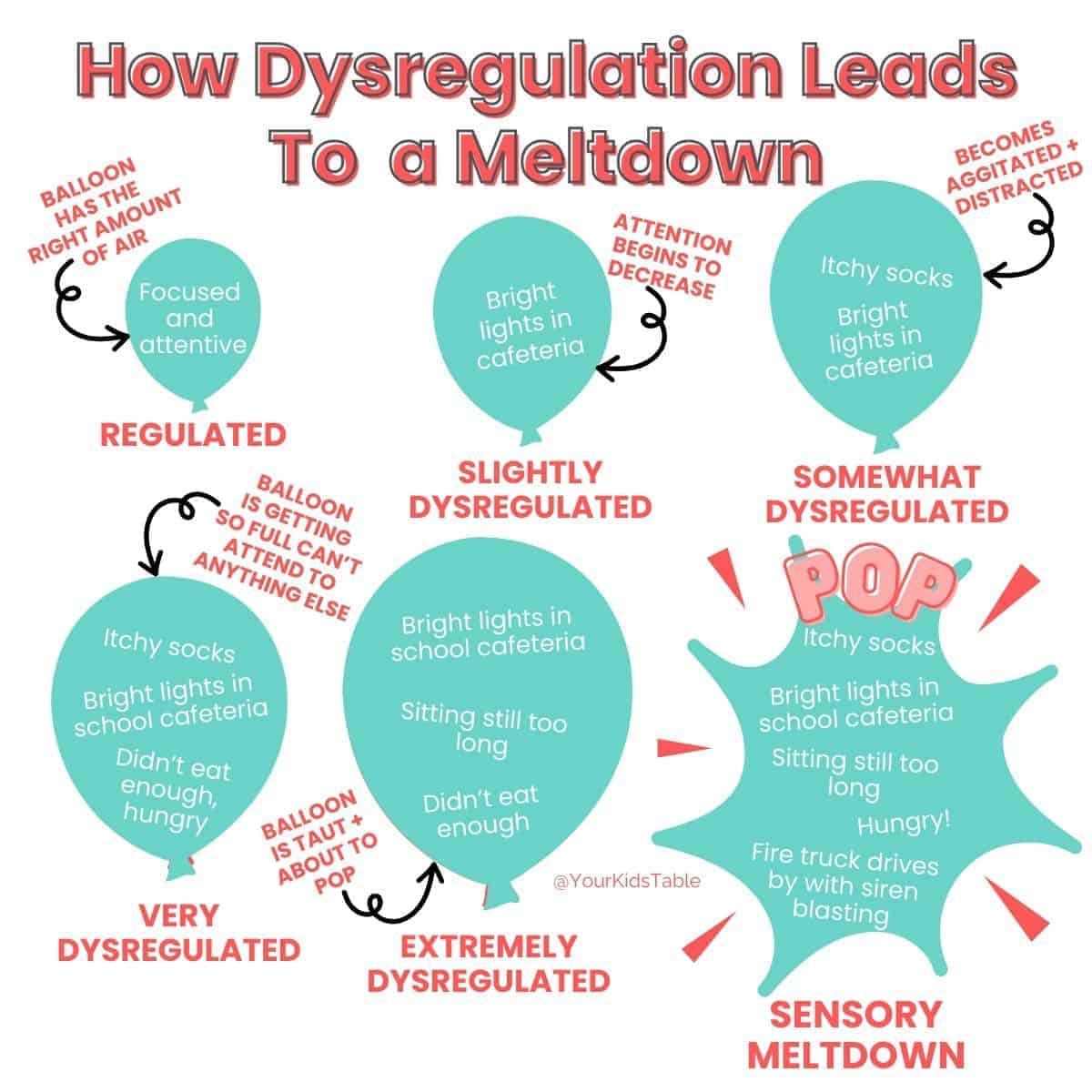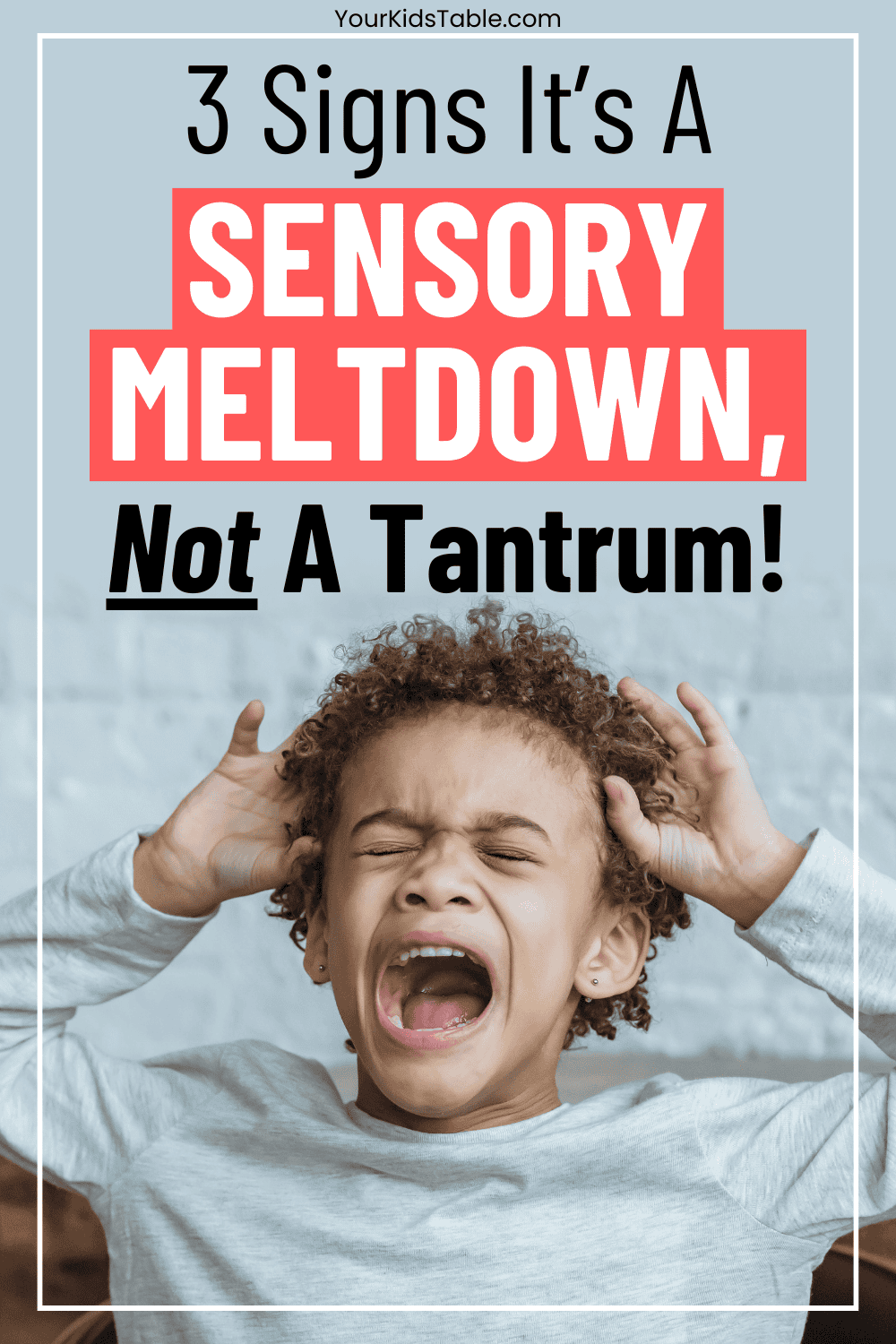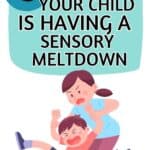Is your child having a sensory meltdown or a tantrum? Learn exactly how to tell the difference between a sensory meltdown vs. tantrum and how to help your child’s sensory processing when they are having a sensory overload meltdown.
As Sarah lifted her son into the shopping cart she thought…
“Maybe it wouldn’t happen this time. I’ll be really quick, and besides, I don’t have a choice, I have to get milk and cough syrup.”
But as soon as Sarah pushed the cart into the grocery store, her son started to whine. Not a good sign. She tried talking to him, asking him what was wrong, but he didn’t answer.
She could only hope that the whining wouldn’t escalate as it usually did. She made a beeline for the milk and ran into an old friend she hadn’t seen in a while. While she chatted, her son began to rock back and forth and the whining turned more into moaning.
Embarrassed and without an explanation for her son’s behavior, she quickly ended the conversation and made her way to the cough syrup. Except they had moved it and the store was getting more crowded by the second.
At this point, her son began rocking harder, shaking the cart. He was trying to climb out. Sarah tried to remain calm, but he was making a scene and everyone was staring.
Not to mention she had no idea what was really wrong with her son. Was he just acting bad because he didn’t want to be in the store? She tried comforting him. Then, talking firmly. And finally, threatening him with punishments.
None of it mattered, because her son only grew more out of control. He began thrashing in the cart, covering his eyes, and yelling.
A few times, he even hit himself in the head. Sarah had no choice but to scoop him up and carry him as he flailed in her arms right out of the store without the milk or cough syrup.
Understandably, Sarah was frustrated, exhausted, and confused by the time she got to the car.
What just happened to her son???
He was having a sensory meltdown.

What is a Sensory Meltdown?
A sensory meltdown is when our brain is maxed out on sensations and can’t take anymore. Another way to think of it is sensory overload, which is why you might also hear the phrases “sensory overload meltdown” or even “overstimulation meltdown”
The question is, why did Sarah’s son have a sensory meltdown in the store, but many other kids don’t? Aren’t they experiencing the same sensations?
The answer is that every single child (and adult) experiences sensations a little bit differently, and some kids experience them VERY intensely.
For Sarah’s son, he may have been bombarded by the:
- bright overhead fluorescent lights
- various smells all around him that he couldn’t get away from in a cart
- the bumps and vibrations of riding in a cart backwards
- buzzing sound coming from the lights
- noise of all the conversations, overhead music, and loud announcements in the store
While you or I may filter all those sensations out, some kids can’t. This isn’t their fault. It’s because of a specific brain function called sensory processing.
Some kid’s brains have difficulty with sensory processing.
Is Autism, SPD, or ADHD the Cause of Meltdowns?
Some kids that have difficulty with sensory processing have no diagnosis at all, but when these difficulties have a significant impact on daily life, they may have Sensory Processing Disorder (SPD), in which case meltdowns are more common.
That makes sense, right? Because their brains aren’t processing all the sensory input well so they overload more easily.
Kids with Autism Spectrum Disorder (ASD) and ADHD frequently also have sensory processing difficulties. It is NOT part of the diagnosis but a co-occurrence.
So, while it’s common for kids Autism and ADHD to have meltdowns, it’s not the cause of the meltdown.
Why Kids Have Meltdowns
Any child can have a sensory meltdown, but for the average kid, this would take A LOT of intense exposure to a multitude of sensations. For kids with sensory processing difficulties, they’re triggered much more easily.
That’s because their brain is often in a state of dysregulation already. Sensory kids notice or need way more sensations, which affects their regulation.
But, dysregulation isn’t like an on and off switch. Instead, think of dysregulation like a balloon.
When a child is regulated, the balloon is comfortably full of air, floating peacefully, without fear of popping.
But a child can become a little dysregulated, and then a little more, but eventually if the dysregulation keeps rising the balloon will reach its limit and burst! Here’s a visual demonstrating how dysregulation leads to meltdown:

Is a Sensory Meltdown Different Than a Tantrum?
Let’s get clear about what a sensory meltdown is and what it’s not. A sensory meltdown is not a temper tantrum, all kids have those at one time or another. Many kids will never experience a sensory meltdown or even sensory overload.
A tantrum and a sensory meltdown can look similar though. And, it’s essential you understand the difference, because dealing with a sensory meltdown looks different than a tantrum.
A tantrum is the result of a child trying to exercise control or get their way. During a tantrum, they sometimes throw themselves on the floor. They might cry or yell. They may even kick and hit because they’re angry or trying to manipulate the situation in their favor.
Tantrums are developmentally normal and expected at certain ages. But even toddlers can have sensory meltdowns along with temper tantrums.
They also could be triggered more easily if they’re hungry or tired and crying or tantruming because they need rest or to eat.
Tantrums of course are not a result of your child being “bad,” there is a reason for those too.
A sensory meltdown is something a child can’t control. It is your child reacting to the sensory triggers of their brain’s wiring, and these sensory processing issues elicit a neurological response.
During a meltdown caused by sensory overload a child may the following sensory meltdown symptoms:
- Cry
- Yell
- Run away
- Hit themselves or others
- Run around and knock things over
- Kick
- Bite
- Thrash around on the ground
- Rock violently back and forth
- Bang their head
If your child has ever experienced a sensory meltdown, you know how utterly heartbreaking and scary it is.
What’s worse though is that often the more you try to help by talking to your child, the more out of control they seem to become.
Onlookers, friends, and family can’t understand this seemingly dramatic behavior or the overwhelming situation your child is in, and commonly suggest the child needs to be disciplined differently.
Parents and the public at large just aren’t taught about sensory processing (that’s part of our mission here at Your Kid’s Table), and so the only explanation is behavior. Because that’s what most people understand.
I highly suggest taking our free sensory workshop to learn more about sensory processing and how it affects kids.
But, that couldn’t be further from the truth.

3 Signs Your Child is Having a Sensory Meltdown Not a Tantrum
Let’s get clear about the difference between a sensory meltdown and a tantrum. If your child is having a sensory meltdown, you’ll know because:
#1. You can’t communicate with them
When a child is having a sensory meltdown, they are almost unreachable. They’ve actually moved into a fight or flight response. Sensory overload and sensory processing challenges trigger the brain to move into fight or flight. Hence the violent (fight) actions or fleeing (flight) you see in your child’s behavior.
Once the brain reaches fight or flight, it’s in a different mode, completely incapable of rational thought. These kids might even have difficulty making eye contact.
Adrenaline is flooding their body and they’re operating from a place of literally trying to save their life, even though they may be in no danger in the middle of your living room or the local Target.
The brain doesn’t know that now and it doesn’t care.
Their brain has no concept of realizing that they’re having a hard time and need a quiet place to calm down.
It felt threatened from the overload of sensations and is responding with a sensory meltdown to protect itself.
When your child is having a tantrum, they may be screaming at you, but you can get their attention. They may be stubborn, but they can understand what you’re saying.
In fact, you might even be yelling back and forth with your child during a tantrum. That would never happen during a sensory meltdown.
#2. They aren’t trying to get something
A tantrum is always the result of a child not getting their way. They want to stay up later, have another cookie, get the new toy, or go with dad on that errand. They may seem like they are having a meltdown when told no, but this is likely not a sensory meltdown, but a temper tantrum.
A sensory meltdown often seems to come out of nowhere, like at night right before bed, while heading out the door, or at one of their favorite places (although there are signs of sensory overload, more on that in a minute).
Sensory meltdowns can build gradually, but it has nothing to do with whether they were allowed to get a milkshake or not while you were picking up dinner in the drive thru lane.
This is where it can get confusing if you have a toddler having a sensory meltdown- the line between meltdown and tantrum can seem blurry with this age.
If you’re ever questioning if your child is having a tantrum or a meltdown, ask yourself if they’re trying to get something as a result of their actions. If it’s a sensory meltdown, the answer is always, no.
#3. Triggered by a sensation(s)
One of the challenges about a child having a sensory meltdown is understanding the cause. Often kids, even verbal older kids, can’t or aren’t able to put into words that the sensory stimuli around them is: too loud, bright, or that it hurts when people keep bumping into them in a crowded space.
However, sometimes your child can give you signs before and during the sensory meltdown. For instance, your kid might squint or keep trying to cover their eyes. They may gasp and start to whimper when somebody accidentally bumps into them.
Or, they may look like they’re on guard cautiously stepping away from everyone because they’re desperately trying to avoid getting bumped into.
Think back about your child’s sensory meltdowns, were there any clues in advance?
Sometimes there isn’t. In that case, you’ll need to think about other sensations in their life they don’t like.
If your child hates riding the swing, movement might be difficult for them. Movement like riding backwards in a shopping cart could make them feel car sick OR extremely insecure and dizzy.
That’s just one example though, let’s talk about some other causes of sensory meltdowns…
Causes of a sensory meltdown
Remember, a sensory meltdown is caused by the sensory system being dysregulated either because there is too much stimulation coming into a child’s brain, or because they’re being deprived of sensations they need to calm and regulate their system.
The following is not a comprehensive list, but includes many sensations that cause or trigger a meltdown. It’s quite possible that a child could experience several of the following to cause a meltdown, as well:
- Loud noises (ice-cream truck, blender, buzzing of lights)
- Bright or flashing lights (overhead lights, holiday lights that blink)
- Smells (candles, food, skunk)
- Movement (spinning, riding in a car, riding in a cart, being lifted off the ground, swinging)
- Touch (certain types of clothing, eating or touching different textures, being bumped into, being touched)
- Clumsiness (feeling unsteady and falling over often)
- Being constrained to move. This may look like “making a child sit still.”
The best way to figure out the cause of your child’s sensory meltdowns though is to ask them when they’re calm, if they’re verbal, why they got so upset.
Don’t underestimate young children answering this question, all they need is a little bit of language to be able to communicate what could be causing their sensory meltdowns.
Bottom line, if you can connect your child’s actions to sensitivity to one or more sensations, then it’s most likely your child is having a sensory meltdown.
What To Do When Your Child is Having a Sensory Meltdown
The best way to help your child when they’re having a sensory meltdown is to make sure they’re safe and then remove the sensation that’s bothering them.
That usually means leaving the store/public setting or going to a quiet room at school/home. If you know the bright, fast moving tv show your other child was watching is contributing to or causing the meltdown, turn it off or help your child get to another room.
If you aren’t sure, try to get them to a quiet dimly lit space without any strong smells, lights, or sounds.
If they’ll allow you, hold them very tightly. Proprioceptive input is incredibly calming to some kids. Some kids will respond well to some slow rocking or vestibular input as well, but for other kids, it’s more sensory input and it will only make the meltdown worse.
This is why there can be a bit of detective work involved in helping your child through a sensory meltdown or overstimulation.
The Best Way to Help is by Preventing the Next Sensory Meltdown
In our RISE with Sensory program, students learn how to help their child in the middle of a tantrum, but also how to prevent it.
You can prevent a meltdown by giving your child supports like wearing noise canceling headphones if noises are the cause of their sensory meltdowns.
Or, maybe they wear a hat to block out bright lights, or sunglasses if visual input is where your child struggles!
But, as an occupational therapist, something I focus on is actually decreasing their sensitivities with specific activities. Basically, a child’s sensory processing can improve for touch, movement (vestibular), and even the smell senses with appropriate and helpful strategies. This technique is called desensitization.
Desensitization takes time because you take small incremental steps to help your child slowly learn to tolerate new textures, smells, and movement. Once that happens, those sensations aren’t triggers for a sensory meltdown any longer.
With this approach, you’re getting to the root of the problem!
To learn more about sensory processing, snag our Sensory Essentials Printable!

More Help for Kids with Sensory Needs
Awesome Sensory Room Ideas That Calm Kids
10 Sensory Red Flags You Might Be Missing
How to Handle a Hyperactive Child
Does Your Picky Eater have Sensory Issues?
Alisha Grogan is a licensed occupational therapist and founder of Your Kid’s Table. She has over 19 years experience with expertise in sensory processing and feeding development in babies, toddlers, and children. Alisha also has 3 boys of her own at home. Learn more about her here.



As an adult, what can I do? Is there a certain type of therapy? It has gotten ao much worse as I age.
Hi KJ,
You can request OT which can help. We also have an online sensory processing course if you’re interested. We have other adults who have taken it for themselves. Let me know if you have questions. It has a 30 day money back option if it isn’t what you’re looking for.
Best,
Laura
Your Kid’s Table team member
Great info. Thanks for sharing this. It’s so important to have resources to pull up in the middle of the night when it’s all happening. Lol.
I am a bit concerned about one thing. Desensitization. I have sensory issues. No amount of touching a rough surface will make it not physically hurt to touch for me. I CAN touch them, but it can cause severe reactions on the wrong day, wrong time, if there are other sensory issues popping up at the time. If I have to touch them, it can be torture and the stress it causes will come out later if not immediately.
The only way I can be desensitized is to basically ignore my body and I can’t tell you how much that has hurt me in my life. Ignoring signals from your body can lead to untreated illness, pushing yourself beyond your limits and accepting pain as normal. It’s not healthy.
I often have to explain to parents the difference between a tantrum and a sensory meltdown. Thanks for sharing this information.
Hey Shannon,
It can be tough! Feel free to share this with your parents if that would be helpful 🙂
Best,
Andrea
This is a very useful article. It’s too bad Alisha feels these phrases are “commonly used in language and parenting”, and wants to keep using them and their implications. Most daycares, schools, professional childcarers, and positive parenting experts and courses now caution against thinking of children as “being bad” (that phrase is a direct quote from the blog). The blog also says “a child should never be punished or disciplined for a sensory meltdown.” As you should know, experts encourage understanding and space, not punishment, for any meltdown at all. A non-sensory meltdown is not the child’s fault, and still always about their developing brains; so punishment is increasingly seen as counterproductive. As so many parents read this blog, one would hope rather than reflecting outdated ideas about children’s emotions, Alisha and her team would want to encourage understanding for children’s emotional and behavioral areas in general.
Hi Sally,
A child’s emotional and behavioral needs are so important! We always encourage positive solutions. Alisha is using that specific language in order to suggest there is a new way to look at tantrums and a better alternative.
Best,
Andrea
Unfortunately while educating us about sensory meltdowns, Alisha us not suggesting there is a new way to look at non-sensory tantrums. She is saying that non-sensory tantrums can still to be thought of as “being bad”. And that for non-sensory tantrums, it may still be ok to administer punishment. (She only says that for sensory tantrums, don’t punish). This is unfortunate, as these days, parenting experts say that ALL tantrums are about brain development, are not kids fault, and none should be punished. (And that in general, punishment as a concept doesn’t work either). They say (non-sensory) tantrums should be dealt with just by reflecting the kids’ feelings, and if necessary, keeping everyone safe. And that it is detrimental to kids, and to adults, to consider that kids are purposely having tantrums, or to refer to them as “being bad”.
Hey Rob,
Thanks for your feedback! We have updated the post to be more clear. We are not implying punishment should be enforced for any child tantrum or sensory meltdown. But do want to explain there is a difference in handling the sensory meltdowns which is why we wanted to get the post out! Hopefully this helps!
Best,
Desiree
Your Kids Table Team Member
I think the misunderstanding comes from this phrase “Is your child having a sensory meltdown or just being bad?”… It could be interpreted asi if it is not a sensory meltdown then the child is beeing bad… as if “regular tantrums” are the sign of bad kids.
I’m sure that is not what you meant but it could be interpreted like that…
Hey Samara,
Yes, that is not what we are saying at all… Alisha utilized those words as they are what are commonly used in language and parenting! But in no way are we stating that the kids are “bad”.
Best,
Desiree
This is helpful thanks. But in differentiating sensory meltdown from tantrum, do you really want to promote the false notion that children can “be bad”? Or that any behavior needs punishment? I’m sure you’ve read “No Bad Children” by Janet Lansbury.
Someone stop this woman. She never said kids who have tantrums (typical toddler behavior) means they are bad children. She is explaining a difference between tantrums vs sensory meltdown. How does this get misconstrued? Good lord. Thank you for your article! -Mom of 3 special needs boys 🧩 who all have DIFFERENT needs. Thank you so much, I really do enjoy reading your blog when I get the time.
Hi Idalia,
We are so glad you’re here! Thanks for sharing that our articles have been helpful to your family.
Best,
Andrea
Hi K,
Thanks for your comment and book recommendation. We are trying to encourage parents to consider an alternative to thinking their children are just acting “bad”. Sensory processing can be the true reason behind many behaviors. Our free sensory workshop is a great place to start if you want to learn more.
Best,
Andrea